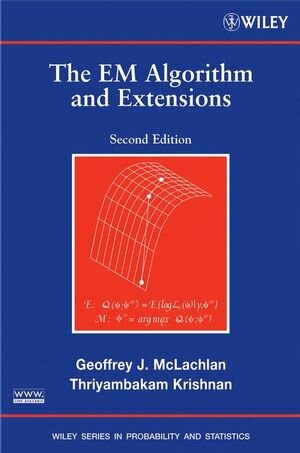
„The EM Algorithm and Extension, Second Edition, serves as an excellent text for graduate-level statistics students and is also a comprehensive resource for theoreticians, practioners, and researchers in the social and physical sciences who would like to extend their knowledge of the EM algorithm.“ (Mathematical Review, Issue 2009e)
The only single-source----now completely updated andrevised----to offer a unified treatment of the theory, methodology, and applications of the EM algorithm
Complete with updates that capture developments from the pastdecade, The EM Algorithm and Extensions, Second Editionsuccessfully provides a basic understanding of the EM algorithm bydescribing its inception, implementation, and applicability innumerous statistical contexts. In conjunction with the fundamentalsof the topic, the authors discuss convergence issues andcomputation of standard errors, and, in addition, unveil manyparallels and connections between the EM algorithm and Markov chainMonte Carlo algorithms. Thorough discussions on the complexitiesand drawbacks that arise from the basic EM algorithm, such as slowconvergence and lack of an in-built procedure to compute thecovariance matrix of parameter estimates, are also presented.
While the general philosophy of the First Edition has beenmaintained, this timely new edition has been updated, revised, andexpanded to include:
* New chapters on Monte Carlo versions of the EM algorithm andgeneralizations of the EM algorithm
* New results on convergence, including convergence of the EMalgorithm in constrained parameter spaces
* Expanded discussion of standard error computation methods, suchas methods for categorical data and methods based on numericaldifferentiation
* Coverage of the interval EM, which locates all stationary pointsin a designated region of the parameter space
* Exploration of the EM algorithm's relationship with the Gibbssampler and other Markov chain Monte Carlo methods
* Plentiful pedagogical elements--chapter introductions, lists of examples, author and subject indices, computer-drawngraphics, and a related Web site
The EM Algorithm and Extensions, Second Edition serves as anexcellent text for graduate-level statistics students and is also acomprehensive resource for theoreticians, practitioners, andresearchers in the social and physical sciences who would like toextend their knowledge of the EM algorithm.
Complete with updates that capture developments from the pastdecade, The EM Algorithm and Extensions, Second Editionsuccessfully provides a basic understanding of the EM algorithm bydescribing its inception, implementation, and applicability innumerous statistical contexts. In conjunction with the fundamentalsof the topic, the authors discuss convergence issues andcomputation of standard errors, and, in addition, unveil manyparallels and connections between the EM algorithm and Markov chainMonte Carlo algorithms. Thorough discussions on the complexitiesand drawbacks that arise from the basic EM algorithm, such as slowconvergence and lack of an in-built procedure to compute thecovariance matrix of parameter estimates, are also presented.
While the general philosophy of the First Edition has beenmaintained, this timely new edition has been updated, revised, andexpanded to include:
* New chapters on Monte Carlo versions of the EM algorithm andgeneralizations of the EM algorithm
* New results on convergence, including convergence of the EMalgorithm in constrained parameter spaces
* Expanded discussion of standard error computation methods, suchas methods for categorical data and methods based on numericaldifferentiation
* Coverage of the interval EM, which locates all stationary pointsin a designated region of the parameter space
* Exploration of the EM algorithm's relationship with the Gibbssampler and other Markov chain Monte Carlo methods
* Plentiful pedagogical elements--chapter introductions, lists of examples, author and subject indices, computer-drawngraphics, and a related Web site
The EM Algorithm and Extensions, Second Edition serves as anexcellent text for graduate-level statistics students and is also acomprehensive resource for theoreticians, practitioners, andresearchers in the social and physical sciences who would like toextend their knowledge of the EM algorithm.






